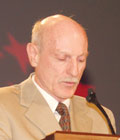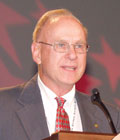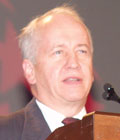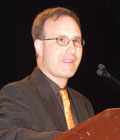The GRANDEST of the GRAND: veterinarians applauded and honored
At the AVMA Annual Convention's General Session, co-sponsored by Bayer Corp. and Hill's Pet Nutrition Inc., several veterinarians were honored for their contributions to veterinary medical organizations, education, public service, humane efforts, and the profession. Dr. Marion T. Szatalowicz, Stanley, Wis., received the AVMA Award for serving the profession with honesty, dedication, and irrepressible passion for more than 50 years. A food animal practitioner and second lieutenant in the United States Army Air Corps, he has been instrumental in numerous associations since earning his DVM degree from Kansas State University in 1951. On a national level, he served as AVMA vice president, Executive Board District V representative and board chair, Wisconsin delegate to the AVMA House of Delegates, and American Veterinary Medical Foundation treasurer and board member. He is a member of the United States Animal Health Association and represented the AVMA on the USAHA governmental relations committee. His knowledge and vision helped positively steer the Wisconsin, Northwest Wisconsin, and Minnesota VMAs, as well as the American Association of Bovine Practitioners, the American Association of Small Ruminant Practitioners, and various cattle producers' associations.
For outstanding contributions to the field of public health and regulatory veterinary medicine, Dr. Joseph L. Blair, Charleston, W.Va., received the Public Service Award. Throughout his 32-year public service career with the USDA's food safety programs, this native of Texas has been instrumental in educating the meat and poultry industries about sanitation and food safety. As a federal-state cooperation officer, he was responsible for implementing the 1967 Wholesome Meat Act and the 1968 Poultry Products Inspection Act in four upper-Midwest states. Working with the Food and Drug Administration, Environmental Protection Agency, and state officials, he helped deplete hepatic residues in livestock in a six-state area and reduce contamination of livestock from the mismanagement of toxic wastes by industrial chemical plants in southern Louisiana. He was involved in developing public health and agricultural federal and state policies, and he supervised the inspection program and import and export of meat and poultry. As assistant to the deputy administrator in the Food Safety and Inspection Service scientific sector, Dr. Blair headed a team charged with implementing a nationwide, computer-based, interagency information-sharing program, which serves today as the linchpin of the cooperative interagency residue control program. A 1957 graduate of Texas A&M University, Dr. Blair has served as vice chair and chair of the United States Animal Health Association's committee on food and is currently executive vice president of the American Association of Food Hygiene Veterinarians. He is also the AVMA alternate delegate for the AAFHV.
Dr. Bernard R. Pinckney, a longtime private practitioner from Tacoma, Wash., received the Meritorious Service Award for developing the concept of using art as a way to enhance the cultural face of veterinary medicine. He has brought the veterinary profession to life throughout the nation by way of three unique statues. The most recent creation, "Team Effort," dedicated to Dr. Leo Bustad and the human-animal bond, is displayed at the AVMA headquarters in Schaumburg. Dr. Pinckney, who received his DVM degree from Washington State University in 1943, also has helped promote the global use of microchips in companion animals.
Dr. Gregory A. Inskeep, owner of a private practice in Rensselaer, Ind., received the AVMA Practitioner Research Award. Dr. Inskeep, a well-known researcher in the field of dentistry, is responsible for numerous papers and presentations. During the past eight years, he has participated in 20 oral health clinical trials. His research has changed the face of veterinary dentistry, from being responsible for changes made to AAHA guidelines to helping products gain approval by the Veterinary Oral Health Council. Dr. Inskeep, who received his DVM degree from Purdue University in 1984, also has developed a treatment to reduce bad breath, plaque, and bleeding gums.
Dr. Saul T. Wilson, Tuskegee, Ala., received the K. F. Meyer/James H. Steele Gold Head Cane Award for achievements in animal health that have advanced human health through the practice of veterinary epidemiology and public health. Through an illustrious federal career, he has trained, managed, and directed domestic and international programs aimed at controlling and eradicating various animal diseases. During his more than 50-year career, he has investigated bovine tuberculosis, hog cholera, screwworms, African swine fever, pseudorabies, avian influenza, exotic Newcastle disease, and Salmonella. As director of the National Program Planning Staff, Veterinary Services, United States Department of Agriculture-Animal and Plant Health Inspection Service, he had a leadership role in developing procedures and policies for licensing the first veterinary biological products produced for foot-and-mouth disease. Dr. Wilson received his DVM degree in 1950 from Tuskegee University.
This year's winner of the Charles River Prize, given for distinguished contributions to the field of science, was Dr. Margaret S. Landi, King of Prussia, Pa., an expert in laboratory animal medicine who resides in Prussia, Pa. A worldwide vice president of laboratory animal science for research and development at GlaxoSmithKline, she provides guidance to more than 400 professional staff members in six countries who work and care for animals in facilities totaling over a million square feet of space. She is noted for helping establish the first postdoctoral program in laboratory animal medicine at her company, among other accomplishments. A board member of the Pennsylvania Society of Biomedical Research, Dr. Landi is also a notable influence in the academic arena, holding adjunct faculty professorships at the University of Pennsylvania, Hahnemann University, and Thomas Jefferson University. She has served on the board of directors for the American Society of Laboratory Animal Practitioners as well as the American College of Laboratory Animal Medicine, where she also attained the role of president.
A past editor-in-chief of the Institute of Laboratory Animal Resources Journal, she has served on review committees and special ad hoc committees for the National Institutes of Health. She received her VMD degree from the University of Pennsylvania in 1979. Dr. Norman F. Cheville, Ames, Iowa, dean of Iowa State University's College of Veterinary Medicine in Ames was honored with the American Feed Industry Award for his outstanding research pertaining to nutrition and disease affecting livestock and poultry production. A distinguished teacher and author of more than 200 scientific papers and seven books, Dr. Cheville has helped define veterinary pathology over the past 20 years. He has made landmark contributions to the understanding of how papillomavirus, pox virus, and infectious bursal disease virus infections develop as well as uncovered fundamental information regarding avian encephalomyelitis, hog cholera, and Newcastle disease. His current research focuses on the pathogenesis and cytopathology of brucellosis, the mechanism of cell death for Pasteurella toxin type D, and cell attachment and trafficking of Mycobacterium spp. While working at the National Animal Disease Center from 1964-1995, he also shed light on leptospirosis, aflatoxicosis, vitamin D metabolism, piglet diarrhea, and bovine mastitis. His research into brucellosis control ultimately led to the production of a new commercial vaccine for cattle.
Dr. Cheville received his DVM degree from Iowa State University in 1959. A former editor of the journal Veterinary Pathology, Dr. Cheville is a past president of the American College of Veterinary Pathologists and the Conference of Research Workers in Animal Diseases. In recognition of his outstanding contributions to the international understanding of veterinary medicine, Dr. Charles M. Barnes, Georgetown, Texas, received the XIIth International Veterinary Congress Prize. He played a prominent role in the Mexico-U.S. Foot-and-Mouth Disease Eradication Commission, and he helped protect the Central American Republics and Colombia from FMD and other exotic diseases as the USDA regional supervisory veterinarian for these regions. Dr. Barnes also helped design programs to use obsolete military aircraft to distribute sterile insects and insecticides in Costa Rica, Nicaragua, Puerto Rico, and Panama, in an attempt to control the Mediterranean fruit fly, African bont tick, and screwworm. When the U.S. and eight Far Eastern countries of Asia formed a cooperative effort to study diseases transmitted by migratory birds and animals, Dr. Barnes was selected by the Armed Forces Institute of Pathology as its veterinarian in charge and program director.
Dr. Barnes also worked for NASA, where he is most noted for helping develop methods to safely work in the radiation belts surrounding the earth, launch major radioisotope power sources into space, and plan for reentry into international atmospheres without seriously contaminating surface areas. Until his recent retirement, he worked extensively in foreign affairs as the CEO of the International Veterinary Medical Foundation, seeking funds to support U.S. and international veterinary colleges. He received his DVM degree from Texas A&M University in 1944. Dr. Rudolf T. Dueland, Black Earth, Wis., received the American Kennel Club Career Achievement Award in Canine Research. One of the first researchers to examine total hip replacement in dogs, Dr. Dueland has been a leader in canine orthopedic research for 30 years. He received his DVM degree from Cornell University in 1956 and is board certified by the American College of Veterinary Surgeons. Dr. Dueland, a professor emeritus at the University of Wisconsin-Madison, introduced the interlocking nail in canine orthopedics as a lower-cost alternative to plating procedures and was the first to describe standardized procedures for performing pubic symphysiodesis, which shows promise for preventing hip dysplasia and is being investigated for its applications in humans.
Dr. Alfred M. Legendre, Knoxville, Tenn., received the Innovative Veterinary Diets Fido Award for his research in small animal medicine. Dr. Legendre, the assistant department chair in Small Animal Clinical Sciences at the University of Tennessee, is one of the most renowned specialists in the field of animal mycotic diseases and has revolutionized the treatment of fungal diseases in animals. His pioneering work on the use of Itraconazone for the treatment of blastomycosis changed the protocol of choice and has proven applicable to a variety of other fungal infections.
Board certified in internal medicine and oncology, Dr. Legendre has also advanced the understanding of feline leukemia, feline infectious peritonitis, and other feline diseases. He is a 1966 graduate of Auburn University. Steve Dale from Chicago received the AVMA Humane Award for his efforts on behalf of animals and his exceptional commitment to animal welfare. As a syndicated pet columnist and radio host, he tackles tough issues and reaches millions of individuals. By conveying humane and scientific information, he aims to enhance pets' lives and create better pet owners. Earlier this year, Dale urged Chicago aldermen to pass an ordinance supporting responsible pet ownership, instead of enacting breed-specific legislation, and worked with legislators and animal experts to write legislation that does not refer to banning of specific breeds. | ||||||||||||

 Dr. Joseph L. Blair
Dr. Joseph L. Blair
 Dr. Bernard R. Pinckney
Dr. Bernard R. Pinckney
 Dr. Gregory A. Inskeep
Dr. Gregory A. Inskeep
 Dr. Saul T. Wilson
Dr. Saul T. Wilson
 Dr. Margaret S. Landi
Dr. Margaret S. Landi
 Dr. Norman F. Cheville
Dr. Norman F. Cheville
 Dr. Charles M. Barnes
Dr. Charles M. Barnes
 Dr. Rudolph T. Dueland
Dr. Rudolph T. Dueland
 Dr. Alfred M. Legendre
Dr. Alfred M. Legendre
 Steve Dale
Steve Dale